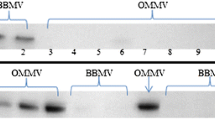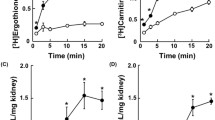Abstract
In order to evaluate the specificity for the contraluminal sulfate transport system the inhibitory potency of phenol- and sulfonphthaleins, of sulfamoyl-compounds (diuretics) as well as diphenylamine-2-carboxylates (Cl− channel blockers) on the35SO 2−4 influx from the interstitium into cortical tubular cells in situ has been determined. The following was found: 1) Phenolsulfonphthalein (phenol-red) inhibited with an app.K i-value of 1.7 mmol/l, while analogs which had additional Br-atoms in position 3 and/or 5, i.e. bromphenol-blue, bromcresol-purple and bromcresol-green, inhibited with an apparentK i of 0.1 and 0.5 mmol/l respectively. 2) Phenolphthalein and tetrabromphenolphthalein did not inhibit, while the disulfonate dyes bromsulfalein, fuchsin acid and indigocarmine inhibited with aK i between ≈1 and 3 mmol/l. The highest inhibitory potency in this class of compounds was seen with orange G (app.K i 0.07 mmol/l). The monosulfonate dyes tested, fluoresceinsulfonate and orange I inhibited moderately with an app.K i of ≈5 mmol/l. 3) The 3-sulfamoyl compounds inhibited to a varying degree, when they had a neighbouring −NH-group (furylmethylamino-group), i.e. in position 6 to the COOH or SO3H-group, or when they had a phenoxy-group in position 4. 4) 4-sulfamoylbenzoate and the related compounds probenecid, acetazolamide and hydrochlorothiazide inhibited with an app.K i between 4 and 7 mmol/l. 5) All diphenylamine-2-carboxylate analogs inhibited with an app.K i between 3 and 5 mmol/l, even when the −NH-group was replaced by an =O-group or the benzene ring was replaced by a pyrimidine ring, but not when it was replaced by a thiophen ring. In contrast, 4-phenylaminepyridine-3-sulfonate was ineffective, while diphenylamine-2-amino sulfonate exerted the highest inhibition of this group with an app.K i of 1.4 mmol/l. When, however, the aminosulfonate group was replaced by a methylsulfonamide, the inhibitory potency disappeared. The data can be explained by inhibitory patterns found in previous papers for disulfonates [29], sulfonates with a hydrophobic moiety [28] or neighbouring OH-group [28, 29], carboxylates with a neighbouring −NH- or OH-group in position 2- and an electron-attracting group in position 5 [30].
Similar content being viewed by others
References
Baer JE, Russo HF, Beyer KH (1959) Saluretic activity of hydrochlorothiazide (6-chloro-7-sulfymoyl-3,4-dihydro-1,2,4-benzothiadiazine-1,1-dioxide) in dog. Proc Soc Exp Biol Med 100:442–446
Bárány EH (1972) Inhibition by hippurate and probenecid of in vitro uptake of iodipamide and o-iodohippurate. A composite uptake system for iodipamide in chorioid plexus, kidney cortex and anterior uvea of several species. Acta Physiol Scand 86:12–27
Beyer KH, Baer JE (1961) Physiological basis for the action of newer diuretic agents. Pharmacol Rev 13:517–562
Darmady EM, Mowles TT, Renzi AA, Sheppard H, Stranack F (1962) The localization of hydrochlorothiazide-3H within the kidney. Clin Sci 22:295–300
Despopoulos A (1971) Congruence of renal and hepatic excretory functions: sulfonic acid dyes. Am J Physiol 220:1755–1758
Forster RP, Sperber I, Taggart JV (1954) Transport of phenolsulfonphthalein dyes in isolated tubules of the flounder and in kidney slices of the dogfish: Competitive phenomena. J cell comp Physiol 44:315–318
Fritzsch G, Haase W, Rumrich G, Fasold H, Ullrich KJ (1984) A stopped flow capillary perfusion method to evaluate contraluminal transport parameters of methylsuccinate from interstitium into renal proximal tubular cells. Pflügers Arch 400: 250–256
Gayer J (1965) Die renale Exkretion des neuen Diureticum Furosemid. Klin Wochenschr 43:898–902
Gerdes U, Kristensen J, Møller JV, Sheikh MI (1978) Renal handling of phenol red. III. Bidirectional Transport. J Physiol 277:115–129
Hewitt WR, Wagner PA, Bostwick EF, Hook JB (1977) Transport ontogeny and selective substrate stimulation as models for identification of multiple renal organic anion transport systems. J Pharmacol Exp Ther 202:711–723
Höber R, Titajew A (1930) Über die Sekretionsarbeit der Leber vom Frosch. Pflügers Arch Ges Physiol 223:180–194
Hong SK, Park YS (1971) Transport of bromcresol green in the rabbit kidney slice. Am J Physiol 221:1779–1784
Hosteman S, Pritchard JB (1976)Organic acid transport: utility of in vitro kinetic measurements to predict effectiveness of inhibitors in vivo. Mount Desert Island Biological Laboratory Bulletin 16:55–58
Kim JH, Hong SK (1962) Urinary and biliary excretions of various phenol red derivatives in the anaesthetised dog. Am J Physiol 202:174–178
Lew HS, Lee EC, Lee KS, Hong SK (1962) Urinary and biliary excretion of dyes in acidosis and alkalosis in the dog. Am J Physiol 203:644–648
Maren TH (1956) Carbonic anhydrase inhibition. IV. The effects of metabolic acidosis on the response to diamox. Bull John Hopkins Hosp 98:159–183
Maren TH (1969) Renal carbonic anhydrase and the pharmacology of sulfonamide inhibitors. In: Handbook of Experimental Pharmacology, vol 24. Springer, Berlin Heidelberg New York, pp 195–256
Peters G, Roch-Ramel F(1969) Furosemide. In: Handbook of Experimental Pharmacology, vol 24. Springer, Berlin Heidelberg New York, pp 386–405
Pratt EB, Aikawa JK (1962) Secretion and effect of hydrochlorothiazide in bile and pancreatic juice. Am J Physiol 202:1083–1086
Sheikh MI (1976) Renal handling of phenol red. II. The mechanism of substituted phenolsulphophthalein (PSP) dye transport in rabbit kidney tubules in vitro. J Physiol 256:175–195
Sheikh MI, Stahl M (1977) Characteristics of accumulation of probenecid by rabbit kidney cortical slices. Am J Physiol 232:F513-F523
Sheikh MI, Maxild J (1978) Kinetics studies on the renal transport of probenecid in vitro. Biochim Biophys Acta 514:356–361
Small A, Cafruny EJ (1965) The renal sites of action of furosemide. Pharmacologist 7:165
Sperber I (1954) Secretion of organic anions in the formation of urine and bile.Pharmacol Rev 11:109–134
Tanner GA, Carmines PK, Kinter WB (1979) Excretion of phenol red by the Necturus kidney. Am J Physiol 236:F442-F447
Ullrich KJ, Rumrich G, Klöss S (1980) Bidirectional active transport of thiosulfate in the proximal convolution of the rat kidney. Pflügers Arch 387:127–132
Ullrich KJ, Fasold H, Rumrich G, Klöss S(1984) Secretion and contraluminal uptake of dicarboxylic acids in the proximal convolution of rat kidney. Pflügers Arch 400:241–249
Ullrich KJ, Rumrich G, Klöss S (1984) Contraluminal sulfate transport in the proximal tubule of the rat kidney. I. Kinetics, effects of K+, Na+, Ca2+, H+ and anions. Pflügers Arch 402:264–271
Ullrich KJ, Rumrich G, Klöss S (1985) Contraluminal sulfate transport in the proximal tubule of the rat kidney. II. Specificity: sulfate ester, sulfonates and aminosulfonates. Pflügers Arch 404:293–299
Ullrich KJ, Rumrich G, Klöss S (1985) Contraluminal sulfate transport in the proximal tubule of the rat kidney. III. Specificity: disulfonates, di- and tri-carboxylates and sulfocarboxylates. Pflügers Arch 404:300–306
Ullrich KJ, Rumrich G, Klöss S (1985) Contraluminal sulfate transport in the proximal tubule of the rat kidney. IV. Specificity: salicylates analogs. Pflügers Arch 404:307–310
Weiner IM (1973) Transport of weak acids and bases. In: Orloff J, Berliner RW (eds) Handbook of Physiology. Renal Physiol. Am Physiol Soc, Washington DC, pp 521–554
Weiner IM, Washington JA, Mudge GH (1959) Studies on the renal excretion of salicylate in the dog. Bull John Hopkins Hosp 105:284–297
Author information
Authors and Affiliations
Rights and permissions
About this article
Cite this article
Ullrich, K.J., Rumrich, G., Klöss, S. et al. Contraluminal sulfate transport in the proximal tubule of the rat kidney. Pflugers Arch. 404, 311–318 (1985). https://doi.org/10.1007/BF00585341
Received:
Accepted:
Issue Date:
DOI: https://doi.org/10.1007/BF00585341




